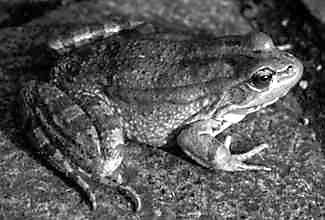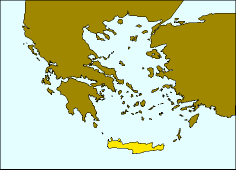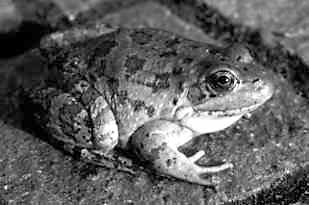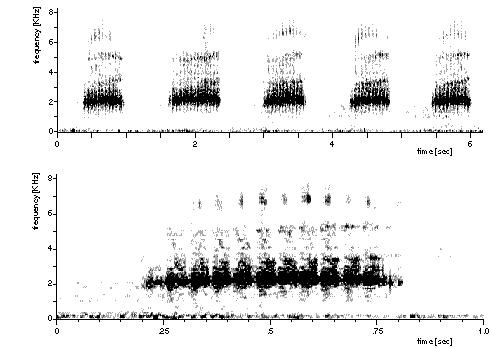Rana cretensis
Peter BeerliIntroduction
[Excerpt of the original description: Beerli et al. 1994]
A member of the western Palearctic water frog group, distinguished from the Palearctic brown frog group by paired external lateral vocal sacs in males, extension of webbing of feet to the toe tips, absence of a black face mask from the eye to the tympanum, and presence of dark mottling on the inner thigh surfaces; distinguished from the eastern Palearctic water frog group by protein electrophoretic data: among the loci sharing no alleles with eastern Palearctic water frogs (at least 50%; cf. Nishioka and Sumida 1992), those at [[alpha]]GDH, LDH-B, sMDH[=MDH-1], MPI, and 6PGDH are shared with one to many species of western Palearctic water frogs, whereas those at LDH-A, mMDH[=MDH-2], and sSOD[=SOD-1] are shared with all.
Rana cretensis is discriminated from all other western Palearctic water frog species by a unique multilocus combination of electrophoretically detected alleles: among alleles shared with other species, our samples are fixed for mACO c, AHH a, CK-A b, aGDH b, mIDH[=IDH-2] b; LDH-B d, sMDH a, MPI q; MPR1[=MProt1] b, 6PGDH e, PGM-2 d, sSOD a. Rana cretensis has unique (private) alleles, all fixed in our samples, at the loci sAAT[=AAT-1] (m), sACO (d), ALB (k), EST-5 (f), EST-6 (d), GPI (h), sIDH[=IDH-1] (g). Centromeres of the 2N=26 chromosomes are conspicuously fluorescent after Actinomycin D / 33258 Hoechst double staining.
Morphologically (Fig. 1), among western Palearctic water frogs Rana cretensis is medium-sized (mean ± standard deviation of body length 64.6±9.5 mm for 8 adults). Relative tibia length medium (body length/tibia length 1.97±0.15, N=37). Callus internus relatively short (body length/callus internus length 18.8±2.7, N=31), of medium height (callus length/height 3.4±0.6, N=8), slightly rounded. Digitus primus medium-sized (body length/digitus primus length 7.3±0.8, N=37; digitus primus length/callus internus length 2.4±0.3, N=37). Dorsal coloration light gray to brown with brown to olive-gray spots, occasionally grass-green with distinct brown spots. Venter and throat uniformly whitish with slight gray pigmentation. No vertebral stripe in our samples. Marked yellow pigmentation on posterior flank and inner side of femur and tibia. Prominent broad brown dorsolateral fold. Vocal sacs of males dark gray.


Fig. 1. Rana cretensis: adult female (paratype, MHNG 2543.91) of 72 mm body length from Petros river, Crete.
Distribution
The distribution of this species is restricted to Crete (Greece). It is the only water frog species known so far on this island.


The map is a transverse Mercator projection and was created with GMT 3.0 (Wessel and Smith, 1995) and postprocessed in Virtuoso on a NeXT, and then converted from eps to gif. [If you need maps, take a look at GMT and create them yourself]
References
Beerli, P. 1994. Genetic isolation and calibration of an average protein clock in western Palearctic water frogs of the Aegean region. Dissertation Universität Zürich 1994. [Summary]
Beerli H. Hotz, H. Tunner, S. Heppich, and T. Uzzell. 1994. Two new water frog species from the Aegean islands Crete and Karpathos (Amphibia, Salientia, Ranidae). Notulae Naturae, Academy of Natural Sciences of Philadelphia 470:1-9.
[see full text]
Information on the Internet
Peter Beerli's Water Frog Info-PoolTitle Illustrations

| Scientific Name | Rana cretensis |
|---|---|
| Type | Paratype |
| Copyright |
© 1995 Peter Beerli

|
About This Page
Peter Beerli

Florida State University, Tallahassee, Florida, USA
Page copyright © 1995 Peter Beerli
All Rights Reserved.
- Content changed 20 December 1995
Citing this page:
Beerli, Peter. 1995. Rana cretensis . Version 20 December 1995 (under construction). http://tolweb.org/Rana_cretensis/17501/1995.12.20 in The Tree of Life Web Project, http://tolweb.org/









 Go to quick links
Go to quick search
Go to navigation for this section of the ToL site
Go to detailed links for the ToL site
Go to quick links
Go to quick search
Go to navigation for this section of the ToL site
Go to detailed links for the ToL site